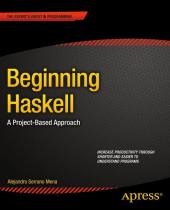 Neuerscheinungen 2013Stand: 2020-01-07 |
Schnellsuche
ISBN/Stichwort/Autor
|
Herderstraße 10
10625 Berlin
Tel.: 030 315 714 16
Fax 030 315 714 14
info@buchspektrum.de |

Alejandro Serrano Mena
Beginning Haskell
A Project-Based Approach
1st ed. 2013. xx, 428 S. 44 SW-Abb. 254 mm
Verlag/Jahr: SPRINGER, BERLIN; APRESS 2013
ISBN: 1-430-26250-8 (1430262508)
Neue ISBN: 978-1-430-26250-3 (9781430262503)
Preis und Lieferzeit: Bitte klicken
Beginning Haskell provides a broad-based introduction to the Haskell language, its libraries and environment, and to the functional programming paradigm that is fast growing in importance in the software industry. The book takes a project-based approach to learning the language that is unified around the building of a web-based storefront. Excellent coverage is given to the Haskell ecosystem and supporting tools. These include the Cabal build tool for managing projects and modules, the QuickCheck tool for software testing, web frameworks such as Yesud and Snap, and the Persistent and Esqueleto database access libraries.
Functional programming is gathering momentum, allowing programmers to express themselves in a more concise way, reducing boilerplate and increasing the safety of code. Indeed, mainstream languages such as C sharp and Java are adopting features from functional programming, and from languages implementing that paradigm. Haskell is an elegant and noise-free pure functional language with a long history, having a huge number of library contributors and an active community. This makes Haskell the best tool for both learning and applying functional programming, and Beginning Haskell the perfect book to show off the language and what it can do.
Takes you through a series of projects showing the different parts of the language. Provides an overview of the most important libraries and tools in the Haskell ecosystem. Teaches you how to apply functional design patterns in real-world scenarios.
Part I: First Steps
1. Going Functional
2. Declaring the Data Model
3. Reusing Code through Lists
4. Using Containers and Type Classes
5. Laziness and Infinite Structures
Part II: Data Mining
6. Knowing Your Clients Using Monads
7. More Monads: Now for Recommendations
8. Parallelizing the Execution
Part III: Resource Handling
9. Dealing with Files: IO and Conduit
10. Builders and Parsers
11. Safe Database Access
12. Web Applications
Part IV: Domain Specific Languages
13. Strong Types
14. Attribute Grammars
Part V: Engineering the Store
15. Documenting, Testing, and Verifying
16. Architecting Your Application
Appendix A
Appendix B
Alejandro Serrano Mena is working towards his PhD thesis inthe Software Technology group in Utrecht University. He is passionate forfunctional programming, and has been coding Haskell for personal andprofessional projects for more than five years. During his college years he wasactive in an association promoting functional languages among students, givingtalks and helping programmers get started in the functional paradigm. In 2011he took part in the Google Summer of Code program, enhancing the Haskellplug-in for the popular development environment Eclipse. His current positioninvolves research for enhancing the way in which developers get feedback andinteract with strong type systems such as Haskell´s.


